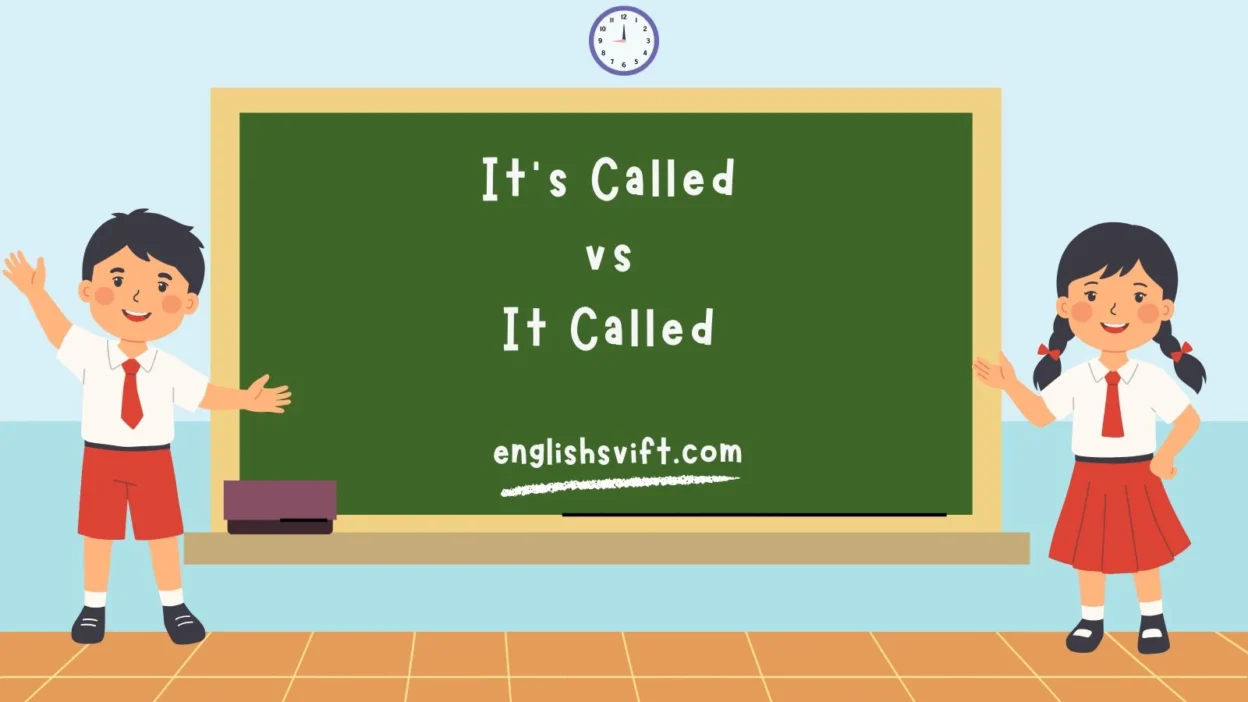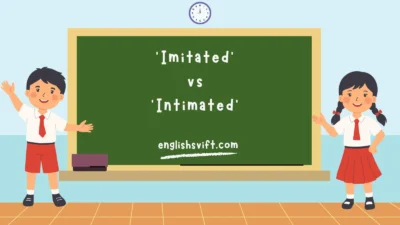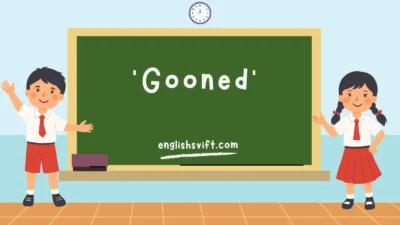If you’ve ever paused mid-sentence wondering whether to say “It’s called” or “It called,” you’re not alone. Many fluent speakers, ESL learners, and even writers trip over this subtle distinction. The two phrases might look similar, but they carry very different grammatical functions, meanings, and contexts.
In this guide, we’ll unpack the difference, avoid common mistakes, and give you real-life usage examples. By the end, you’ll not only master the choice between It’s called and It called but also improve the clarity, accuracy, and confidence in your everyday English communication.
The Essential Difference Between “It’s Called” and “It Called”
At first glance, the difference is just an apostrophe and an “s.” But that tiny mark changes everything.
| Phrase | Grammar Function | Meaning | Example |
| It’s called | Contraction of It is called | Used to name, identify, or describe something | “It’s called a hammock.” |
| It called | Past tense (active voice) of call | Means it performed the action of calling | “It called my phone yesterday.” |
👉 Quick rule of thumb:
- If you’re naming or labeling, use “It’s called.”
- If you’re describing an action done by “it” in the past, use “It called.”
Why Clarity and Accuracy Matter in English Communication
Clarity isn’t just a grammar issue—it’s an essential skill for better conversation, essays, business writing, and even storytelling. Saying “It called a hoverboard” instead of “It’s called a hoverboard” confuses the audience and breaks the flow of communication.
Think of grammar like a satellite system: one small mistake in alignment, and the whole signal drops. Accuracy ensures your ideas land where they’re supposed to.
Breaking Down the Phrase “It’s”: Contraction, Meaning, and Usage
The word “It’s” is short for “It is” (or sometimes “It has”).
- Correct: “It’s raining.” → (It is raining)
- Correct: “It’s called mochi.” → (It is called mochi)
- Incorrect: “Its called mochi.” (missing apostrophe)
⚡ Grammar trick: If you can replace it with “It is” or “It has” and the sentence still works, then “It’s” is correct.
Understanding the Verb “Call” in English Grammar
The verb call has multiple forms and meanings depending on tense and context.
| Form | Function | Example |
| Base (call) | Present/general action | “I call my friend daily.” |
| Past (called) | Completed action | “She called yesterday.” |
| Participle (called) | Used in passive | “It’s called recursion.” |
| Gerund (calling) | Ongoing | “He is calling now.” |
When combined in “It called,” the subject (“it”) is doing the action.
When combined in “It’s called,” the subject (“it”) is being named or described.
Passive vs Active Constructions: How They Shape Meaning
- It’s called = Passive voice (the object is being named).
- Example: “It’s called asymmetric cryptography.”
- Example: “It’s called asymmetric cryptography.”
- It called = Active voice (the subject performs the action).
- Example: “It called for help.”
- Example: “It called for help.”
| Voice | Structure | Usage |
| Active | Subject + verb + object | “The device called me.” |
| Passive | Subject + is/was + past participle | “It’s called encryption.” |
👉 Passive isn’t “wrong,” but it’s used differently—especially in naming, definitions, and introductions.
Common Mistakes ESL Learners Make with “It’s Called”
ESL students often confuse the two because both look similar. Here are the top mistakes:
- ❌ “It called a smartwatch.” (wrong – the watch isn’t performing an action)
- ✅ “It’s called a smartwatch.” (correct – naming the object)
- ❌ “It’s called yesterday.” (wrong – tense mismatch)
- ✅ “It called yesterday.” (correct – past tense action)
💡 Tip: Ask yourself—Am I naming something or describing an action? That question clears up 90% of confusion.
How “It Called” Appears in Creative Writing and Storytelling
Although less common, “It called” shines in literary contexts.
- “It called to me from the shadows.”
- “The radio crackled, then it called my name in a whisper.”
- “It called the team into action, and they won.”
This form creates suspense, atmosphere, and narrative tension. Writers often use it in fantasy, horror, or suspense genres where objects, forces, or abstract ideas perform actions.
Real-Life Examples: When to Use “It’s Called” Correctly
Everyday life is full of naming situations:
| Scenario | Example |
| Introducing products | “It’s called the HoverX Smartwatch.” |
| Education | “In math, it’s called reverse engineering.” |
| Pop culture | “Have you watched The Mandalorian? It’s called a fan favorite.” |
| Food | “That snack? It’s called mochi.” |
| Apps & tech | “There’s a new learning app. It’s called Duolingo.” |
👉 If you’re naming, labeling, or introducing, stick with It’s called.
The Role of Tense: Past, Present, and Perfect Forms
- Present simple: “It’s called recursion.” (general fact)
- Past simple: “It called for attention yesterday.” (action already done)
- Present perfect: “It’s called many times before.” (has happened over time)
⚠️ Mixing them incorrectly leads to awkward, grammatically incorrect sentences.
Sentence Structure: Identifying Subject, Verb, and Object
| Phrase | Subject | Verb | Object/Complement |
| It’s called recursion. | It | is called | recursion |
| It called my phone. | It | called | my phone |
👉 Always break a sentence into parts if you’re unsure.
The Function of Naming, Labeling, and Identifying in Language
Language works like a map: words label ideas, things, and actions.
- “It’s called encryption.” = labeling a concept.
- “It’s called June 21, 2025, Grace Marie Day.” = identifying a date/person.
Correct labeling is crucial for clarity in education, products, and communication.
Grammatical Functions of “It’s Called” in Spoken vs Written English
- Spoken English: “It’s called a hammock.” (casual, quick)
- Written English: “This technique is called recursion.” (formal, structured)
| Context | Preferred Form |
| Everyday conversation | “It’s called” |
| Technical writing | “It is called” |
| Storytelling | “It called” |
Context Matters: Academic Essays vs Casual Conversation
- Academic essays: “This process is called asymmetric cryptography.”
- Casual speech: “It’s called a trick.”
- Storytelling: “It called the children home.”
👉 Knowing your audience helps you choose the right phrase.
Synonyms and Related Phrases for “It’s Called”
| Phrase | Usage Example |
| “It is known as” | “It is known as a winning strategy.” |
| “It goes by” | “It goes by the name recursion.” |
| “It’s referred to as” | “It’s referred to as a subtle technique.” |
These alternatives improve your vocabulary and make essays less repetitive.
The Apostrophe in “It’s”: Contraction vs Possessive Form
- It’s = It is / It has
- Its = Possessive (belonging to it)
| Form | Example |
| It’s | “It’s called recursion.” |
| Its | “The device lost its data.” |
👉 This is one of the most common mistakes in English.
Recognizing and Correcting Common Errors in Usage
| Wrong Sentence | Correct Sentence |
| “Its called encryption.” | “It’s called encryption.” |
| “It’s called yesterday.” | “It called yesterday.” |
| “It called a snack.” | “It’s called a snack.” |
💡 Checklist before writing:
- Am I naming? → It’s called
- Am I showing past action? → It called
How Native Speakers Use “It’s Called” Naturally
Native speakers often shorten things:
- “It’s called recursion.” (neutral)
- “It’s called being smart.” (colloquial emphasis)
- “It’s called luck.” (sarcastic, casual tone)
Tone and delivery can change the effect, but grammar stays consistent.
Comparing “It’s Called” With Other Passive Phrases in English
| Phrase | Function | Example |
| It’s called | Naming | “It’s called recursion.” |
| It’s known as | Reputation | “It’s known as the chef’s signature dish.” |
| It’s referred to as | Labeling | “It’s referred to as reverse engineering.” |
The Influence of Pop Culture: From Disney’s Mandalorian to Everyday Speech
Pop culture constantly introduces new names:
- “It’s called Baby Yoda, but the real name is Grogu.”
- “It’s called a viral trend.”
- “It’s called wallow-watching.”
👉 Grammar stays the same, whether you’re talking about Disney series, apps, or slang.
Tips for ESL Students: Improving Fluency with Naming Phrases
- Practice with objects: “It’s called a pen, it’s called a dial, it’s called a hoverboard.”
- Use checklists: Before speaking, check—naming or action?
- Do multiple-choice quizzes:
- Q: “___ called yesterday.”
- a) It’s
- b) It
- a) It’s
- Q: “___ called yesterday.”
Correct answer: b) It
Examples of Incorrect Usage and How to Fix Them
| Incorrect | Fixed |
| “It’s called yesterday.” | “It called yesterday.” |
| “It called a method.” | “It’s called a method.” |
Mistakes happen—but correcting them improves fluency and confidence.
Using Tables, Quizzes, and Checklists for Grammar Mastery
👉 Quick checklist for learners:
- ✅ “It’s called” = Naming, defining, labeling
- ✅ “It called” = Past tense action
- ❌ Don’t mix tenses (yesterday with “It’s called”)
Fun and Memorable Tricks to Remember the Difference
- Think of It’s called as an introductory statement (naming).
- Think of It called as action performed in the past.
- Mnemonic: “If you’re naming, add the apostrophe ‘s.’”
Enhancing Confidence in Communication Through Correct Usage
Getting this small detail right makes your speech effortless, precise, and natural. Whether you’re:
- Writing essays
- Giving presentations
- Talking casually with friends
…you’ll avoid awkward mistakes and improve your language fluency.
What is it Called
The phrase “It’s called” is a contraction of “It is called.”
👉 We use it when we want to name, label, or describe something.
Examples:
- “It’s called a hammock.” → naming an object
- “It’s called recursion.” → defining a concept
- “It’s called teamwork.” → labeling an idea
So, whenever you’re introducing the name of something, the correct phrase is “It’s called.”
Here’s a quick comparison table for you 👇
| Phrase | Grammar Use | Meaning | Example |
| It’s called | Contraction of It is called | Used to name, label, or describe something | “It’s called mochi.” |
| It called | Past tense of call | Means it performed the action of calling | “It called me yesterday.” |
👉 Tip:
- Use “It’s called” when giving a name or definition.
- Use “It called” when describing an action in the past.
Final Thoughts: Why Mastering “It’s Called” Builds Stronger Language Skills
Mastering this distinction isn’t just about grammar—it’s about confidence, credibility, and connection. The difference between “It’s called” and “It called” might seem small, but it’s the kind of subtlety that separates fluent speakers from those still struggling.
Remember: If you’re naming → It’s called. If you’re showing action → It called.
FAQs
Q1. Is “It called” ever grammatically correct?
Yes. “It called” is correct when “it” performed the action in the past, e.g., “It called my phone yesterday.”
Q2. Why is “It’s called” more common?
Because we use it for naming, labeling, and definitions in everyday communication.
Q3. How do I avoid confusing “It’s” with “Its”?
Remember: It’s = “It is” or “It has.” Its = possession.
Q4. Can I use “It’s called” in academic essays?
Yes, but write it formally as “It is called” in academic contexts.
Q5. What’s the best way to practice this grammar point?
Use real-life examples, do quizzes, and repeat phrases aloud until they feel natural.



